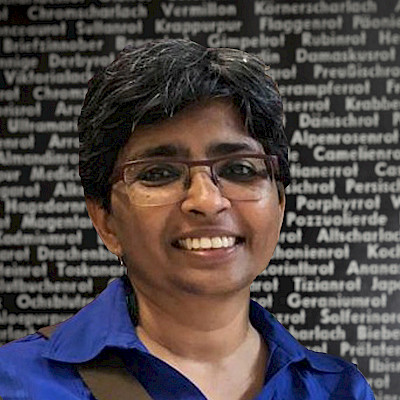My research and publications engage both the historical and the contemporary contexts of India, focusing particularly on cultural, visual and material texts, and rethinking the politics of the contemporary. Thematically, research areas of interest can be divided broadly into the study of family and kinship, both historically and theoretically; different aspects of questions of aesthetics and modernities; visual culture and theory; and religion and faith practices.
One part of this research focuses on modern Kerala and South Asian histories. Another set of interests explore contemporary art and visual cultural practices, focusing mainly on painting and photography. Here questions of interest have focused on engaging the complex intersection of the aesthetic with the political, and opening up ways of theorising this relationship. A final set of research concerns focus on different areas of contemporary politics - from food cultures, community identities, contemporary histories of violence and resistance, and different aspects of thinking gender based rights.
Photography, Painting, Visual Culture, Visual Theory, Modernity, Gender, Caste, Identity, Religion
Are Visions Marginal? Or How May We Unravel the Relationship between Art and Politics?
The relationship between art and politics is complex, often fraught, and cannot always be understood using frames that are anchored by conventional art historical/theoretical analyses. This research is part of a book project, and started as an attempt to answer what appears to be an innocuous, and simple, question – how does one understand Indian women’s artistic production? In time the attempt to grapple with this question expanded the purview of the research, as the question about gender was constantly being disturbed, and ‘rearranged’, by cultural texts produced by artists, whose self identified positionality (queer, lower caste) was anchored differently. Like the work by certain kinds of women artists, the cultural interventions by Dalit (erstwhile ‘untouchable’ castes of India) and queer artists disturbed stock expectations of art, as also the ‘task’ of the artist. Given the difficult and complex relationship that art, politics, and theory have with each other, this study suggests that critical writing on art is best read as a site of struggle to navigate this terrain, rather than a process of providing a definitive opinion. In the spirit of such an enterprise, which would be in keeping with the work of many artists whose work simultaneously invokes and critiques political categories, this study shall bring art practices into conversation with the social and institutional context of art production, and the complex histories of circulation and spectation. Alongside, it is important to not permit an over politicised theoretical/critical reading eclipse the kinds of spaces of openness and possibility in interpreting ‘works of art’ that artists themselves would demand. Here, the challenge is to think of how social origin (caste, class or community origin) and artistic journey (both educational and experimentations with form) might inflect the manner in which one understands the artist, and her work of art? This is especially relevant as the work of artists from marginal communities, while often addressing their location or identity, does not necessarily translate into predictable visual forms that necessarily chronicle either deprivation or resistance.
2016. ‘Bonds of Love, Ties of Kinship?: Or Are there Other Ways of Imagining the Family’, Indian Economic and Social History Review, Vol. 53, 3, (September, 2016).
2015. ‘Ravi Varma’s Many Publics: Circulation and the Status of the “Art-Work”’, in Divya Dwivedi and Sanil V. ed., The Public Sphere from Outside the West, Bloomsbury Academic, London.
2015. ‘Reading, Writing, Region: the Early Malayalam Novel and the Problem of Identity’, in N. Jayaram ed. Ideas, Institutions, Processes: Essays in Memory of Satish Saberwal, Orient Blackswan.
2012. ‘Anna: the Image of India?’, Cultural Critique 81, Spring.
2006. ‘Imagining Communities - Differently: Print, Language and the ‘Public Sphere’ in Colonial Kerala’, Indian Economic and Social History Review,XLIII, 1, January-March.
2003.‘‘Face Value: Raja Ravi Varma’s Portraiture and the Aesthetics of Colonial Modernity’, Indian Economic and Social History Review, 40, 1.
